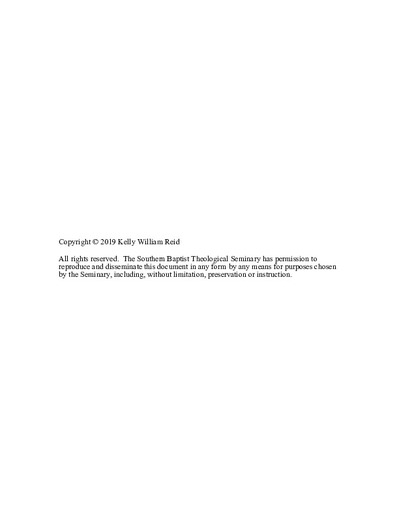| dc.contributor.advisor | Terry, John Mark | |
| dc.contributor.author | Reid, Kelly William | |
| dc.date.accessioned | 2019-12-05T13:37:00Z | |
| dc.date.available | 2019-12-05T13:37:00Z | |
| dc.date.issued | 2019-12-02 | |
| dc.identifier.uri | https://hdl.handle.net/10392/5991 | |
| dc.description.abstract | This dissertation demonstrates that a more thoroughly indigenized Canadian National Baptist Convention (CNBC) will have a greater impact on lostness throughout Canada by providing an effective denominational structure ready to meet the challenges of Canadian ministry in the twentieth century.
Chapter 1 establishes the unique role of the Southern Baptist Convention (SBC) in Canada in two ways. In no other country does the SBC have active participation from both domestic and foreign mission boards. Also unique to Canada, the SBC partners with the CNBC as if it were a quasi-state convention. The introductory chapter also sketches the rise of Southern Baptist church planting in Canada.
Chapters 2 and 3 demonstrate the unique cultural and historical dynamic between the CNBC and SBC. Chapter 2 contends that Canada is a distinct and separate culture from the United States. While acknowledging the reality of multiple regional differences throughout North America and several similarities between Canada and the United States, this dissertation traces the fundamental cultural differences to the distinct national journeys to independence. Chapter 3 provides the historical origins and the early development of the CNBC through the unique partnership with the SBC.
Chapters 4 and 5 describe the progression of thought on indigenous and contextualized missiologies. Chapter 4 examines the literature related specifically to indigenous missiology beginning with Rufus Anderson and Henry Venn. Chapter 5 examines the development of contextualization. While most contextualization models have focused primarily on the communication of the gospel, for the purposes of this dissertation, there is a special emphasis on the role of contextualizing national organizations and structures.
Chapter 6 establishes a specific near-culture contextual model that will be applied to the CNBC, specifically as it relates to the partnership with the SBC. The near-culture contextual model borrows from several contextualization models as they relate specifically to organizational structure and leadership while incorporating the strengths found within indigenous missiology. In doing so, the dissertation acknowledges the significant contributions of the SBC, while calling for a more thoroughly indigenized CNBC. | en_US |
| dc.subject.lcsh | Southern Baptist Convention--Missions--Canada | en_US |
| dc.subject.lcsh | Baptists--Canada | en_US |
| dc.title | Southern Baptist Convention Missions in Canada: An Indigenous Missiology for a Convention in a Near-Culture Country | en_US |
| dc.type | Electronic dissertation | en_US |
| dc.type | Text | |
| dc.contributor.committee | Klaassen, John M. | |
| dc.contributor.committee | Martin, George H. | |
| dc.type.qualificationname | Ph.D. | en_US |
| dc.publisher.institution | Southern Baptist Theological Seminary | en_US |
| dc.publisher.department | School of Missions and Evangelism | |

